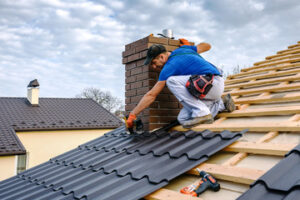Think of your roof as a sturdy umbrella shielding you from the elements. Roofing is the invisible art of handcrafting and maintaining that umbrella—a complex process with many parts.

Choosing the right materials, expert installation, regular inspections, and occasional repairs are just a few of the chapters in your roof’s ongoing story. Contact EZ Roofing of Flagler County for professional help.
When re-roofing your home, the roofing materials you choose will have an enormous impact on how beautiful and unique your new roof looks. You’ll also have the choice of how much protection it offers your home from the elements. Today’s roofing industry has evolved to offer a wide selection of alternatives to traditional roofing options like asphalt shingles, clay or concrete tiles and cedar shakes.
Asphalt shingles are the most common roofing material for homes across America. They provide a cost-effective solution that is easy to install and repair. These shingles are available in different textures and colors to enhance the beauty of your home and they come with a manufacturer warranty. For homeowners in areas that experience a lot of hailstorms, look for the impact-rated varieties of these shingles.
Metal roofing is another excellent option for home owners looking for a more stylish, durable, and long-lasting roof. These roofing systems are made from panels that are locked together or seamed mechanically. They are available in various metals, but the standing seam metal is recommended for residential roofs. They are resistant to a variety of weather conditions and can last for up to 50 years.
Concrete and clay tiles are a more expensive option but have a longer lifespan than a shingle roof. They are extremely durable and can withstand fire, high winds, and even earthquakes. They are also highly water-resistant and do not need a protective underlayment to prevent damage from the sun’s UV rays. These are not the ideal choice for areas that see a lot of rain because they can be prone to cracking or breaking.
Synthetic shingles are a relatively new type of roofing material. They are made from a blend of a fiberglass base with colored mineral and asphalt granules. These shingles can be manufactured to mimic the look of other types of roofing materials, including slate or wood shingles. They can last up to 30 years and are a good choice for most types of houses.
Green roofs are a wonderful alternative for people who want to add a touch of nature to their home. These roofs are topped with plants and can help lower air temperatures, reduce rainwater runoff, improve indoor air quality, and insulate your home to save on energy costs. These eco-friendly roofs are complex to install and require extra structural support, vapor barriers, drainage, soil, water filtration, insulation, waterproofing, and plant selections.
Installation
The roof is the shield that protects your home from the elements. Roofing is the process of installing, maintaining, and repairing that shield. There are many different types of roofing, each with its own benefits and drawbacks. Read on to learn more about the different types of roofing and the installation process.
Before starting work, the roofing contractor will set up protective measures on your property. They will cover landscaping with tarps and put wooden boards down to prevent anything from getting wet from falling debris. They will also cover any open drains to prevent them from becoming blocked by shingle debris.
Once the protective measures are in place, the roofing crew will begin by installing underlayment. This is a waterproof membrane that goes down before the shingles and helps to keep water out of your home, even if the top layer of shingles gets damaged. The roofing contractor will then nail down the shingles. They will start at the bottom edge and work their way up, overlapping each row by four to six inches. They will also use a shingle cap, which is a special type of nail that prevents leaks and ice dams by covering the nail hole with a sealant.
The last step of the roofing process is to check for proper ventilation and insulation. The roofing contractor will make sure that the vents are properly installed and that there is enough insulation to meet building codes. Then, they will perform a final inspection and cleanup of the job site. This includes removing all debris and nails from the property, guaranteeing that no stray pieces of roofing materials end up in your garden or garage.
Maintenance
A roof is an important component of a building, shielding occupants from the elements and providing energy efficiency. But even the sturdiest roofing materials need regular maintenance to prevent leaks and structural damage. A well-structured roofing maintenance program extends the life of a structure and enhances its overall value.
Regular inspections by trained personnel are essential to identifying problems before they become serious. Detailed records of inspections, repairs and all maintenance activities allow for future comparisons, forecasting needs and budget planning. This helps reduce maintenance costs by limiting the extent of deterioration and making early repair more cost-effective.
During these inspections, all aspects of the roof should be carefully examined. This includes the pitch pans, flashings, physical damage to shingles and other components, sealant failures, ponding water or blisters and the presence of moss, algae or accumulated debris. Inspectors should pay particular attention to areas around penetrations, such as chimneys, vents and skylights, where leaks may occur.
Leaks and other damage should be repaired immediately. This will minimize damage to interior finishes, limit the spread of mold and other bacteria and protect underlying structural components from premature deterioration.
In addition, a routine cleaning of the entire roof should be performed periodically. Debris such as leaves, twigs and dirt should be removed, as they can trap moisture and accelerate shingle deterioration. In addition, clogged gutters and downspouts can cause water to back up into the roof system, causing leaks and other damage. Field and auxiliary drains should also be cleared of debris to avoid localized ponding, which can lead to roof system collapse.
Optimal timing of these and other maintenance tasks is crucial to minimizing disruption to the building occupants. For example, a thorough roof inspection in the fall in a region prone to heavy snowfall can help prevent serious issues during winter. The ability to complete these tasks in a timely manner also reflects well on a maintenance company and enhances client satisfaction.
Repairs
Roofing repairs aren’t as easy as giving your home’s cabinets a fresh coat of paint. Roofing can be dangerous and should be left to professionals who have the training, experience and equipment to work safely at heights.
Repairs are necessary when roof damage occurs from wear and tear, weather, or other factors. It is also important to carry out repairs in a timely manner so that serious issues don’t develop, such as leaking or structural damage.
Smaller repairs are usually easy and quick, such as replacing a few damaged shingles or fixing chimney flashing. However, major repair projects such as repairing leaks, sagging or improving ventilation may take days to complete. These types of projects often involve more than one worker and can be challenging due to the complex structure of many residential roofs.
Re-roofing is the simplest and cheapest way to restore your roof’s appearance, but it does not offer the protection of a full replacement. Without removing the old shingles, there’s no way to know if there are any hidden damages underneath that would require additional work or replacement. Plus, re-roofing can void your shingle warranty.
Re-roofing is typically the best choice for a home in need of cosmetic restoration, but it’s important to consult with an expert before making this decision. They can help you understand the cost differences between repairs and replacements, so you can make an informed decision about which is better for your home. And, they can help you understand the differences between manufacturer and workmanship warranties so that you’re fully aware of what coverage you’re getting with your new roof. Also, they can help you determine if you need to get a permit, which will vary depending on your location.
